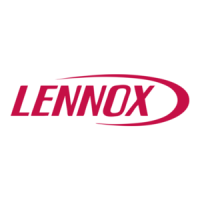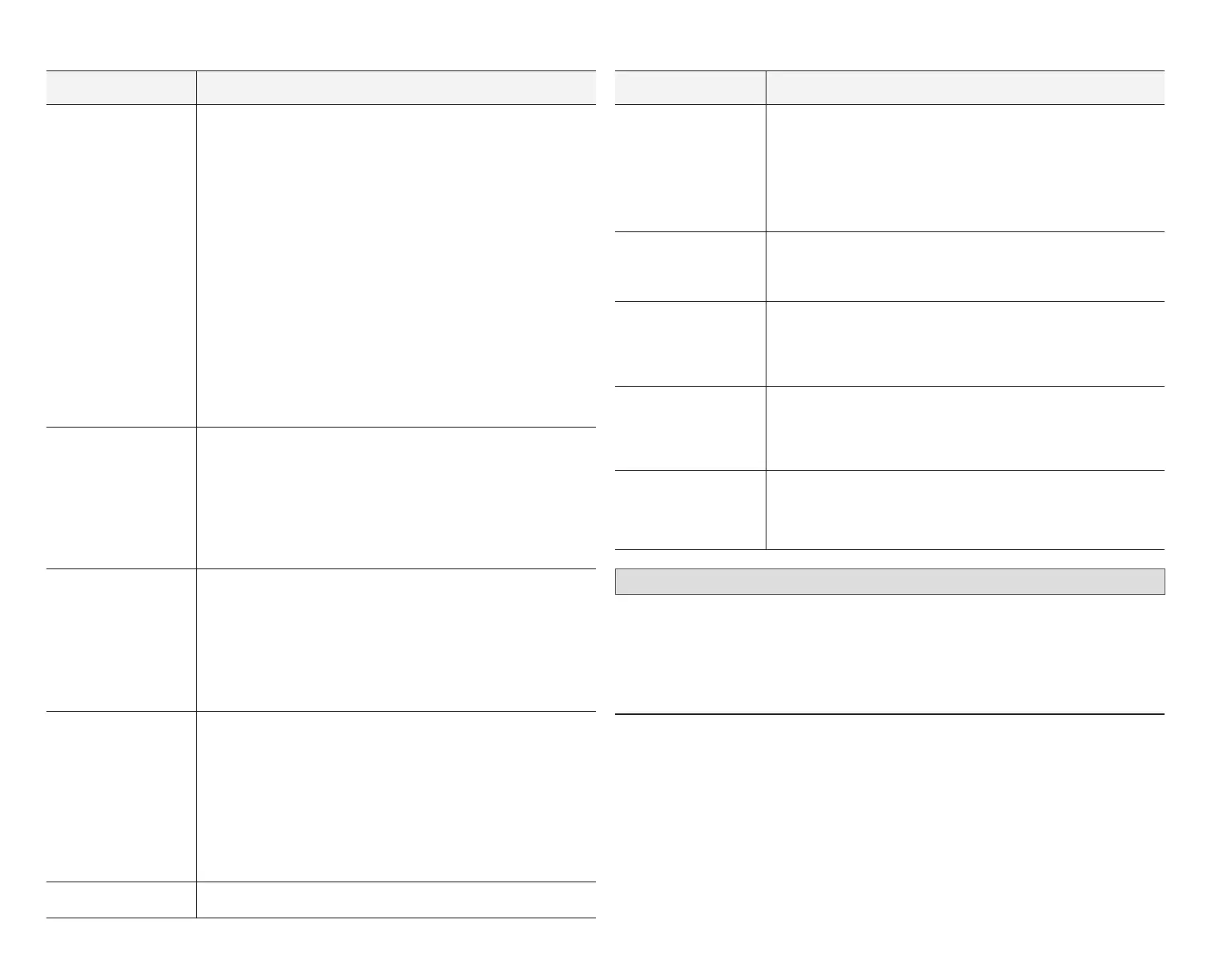21
Table 23. Smart Hub Parameters
Parameter Description
Zone 1 through 4
Heating CFM
The maximum airow CFM is the factory default value for each
particular unit. Depending on each unit’s conguration, the default
values may be applied by the gas furnace, the heat pump unit, or
the air handler electric heating value.
The per zone CFM value is the equal division of the number of
zones into the maximum airow default CFM.
These values will be veried and/or adjusted in the procedure listed
in “Mapping the Design” on page 9.
Specic maximum airow and per zone CFM is achieved by
selecting the mid-range temperature rise values from the CFM
tables listed under “Zoning CFM Tables” on page 17, that will
operate <79% IDBP during the test procedures listed under “Testing
the Zones” on page 11 and “Sizing the System” on page 10.
iHarmony minimum CFM listed below will exceed proper
temperature rise operating ranges. Do not use any value less than
the absolute minimum CFM listed in the blower tables regardless of
tonnage value.
The minimum CFM is 250 CFM for 3-ton, 380 for 4-ton or 450 CFM
for 5-ton to the maximum .
Adjustment are in 5 CFM increments.
Zoning Anticipated
Discharge Air
Temperature
Adjustment
This parameter setting compensates for a rapid change of the
discharge air temperature due to fast changing conditions. It
examines the change in the discharge air temperature for the
previous two minutes and extrapolates or looks forward by the
number of seconds set in the parameter and uses this as the DATS
value for staging. This parameter setting helps prevent limit trip/
frozen coil from occurring.
Range is 0 to 120 seconds. Default is 0 seconds. Adjustments are
in increments of 5 seconds.
Zoning Gas
Heating DAT Cool
Down Target
At the end of a gas cycle, the Heat Blower Off-Delay may not be
long enough to completely cool the heat exchanger. This may result
in a primary limit trip then, or at the beginning of the next heat
demand. This parameter allows the blower to run after a gas heat
call ends until the discharge air temperature sensor (DATS) cools to
the temperature set in the parameter. If the temperature is set too
low this will cause the temperature in the room to overshoot.
Range is 80 to 90°F (26.67 - 32.22°C). Default is 90°F (32°C).
Adjustments are in increments of 1°F (0.56°C).
Zoning Initial
Staging Hold Time
for Gas Heating
In zoning systems, the furnace was upstaging before the discharge
air sensor reached a steady-state value and it would sometimes trip
a limit due to staging up the gas before the blower would even come
on (as occurs during pressure switch calibration).
The furnace has satised the original call for heating and may
still have residual heat in furnace when a second heat demand
is called for. This parameter will not allow for the second call of
heating before the delay timer has expired. This parameter allows
an adjustment on top of the initial delay for a heating call. Range is
3.0-8.0 minutes with a default of 5.0 minutes. Can be adjusted in
1-minute increments
Zoning Minimum
Zone Run-Time
Range is 90 to 600 seconds. Default is 120 seconds. Adjustments
are in increments of 30 seconds.
Table 23. Smart Hub Parameters
Parameter Description
Zoning Supply
Air Temp Limit
for Cooling
In cooling mode, this setting sets the discharge air temperature
low limit. Below this temperature, the cooling is turned off. During
cooling testing set the Zoning Supply Air Temp Limit for Cooling low
enough (far enough away) so that the outdoor unit does not have
nuisance low pressure switch trips caused by a sudden drop in
supply air temperature as dampers close.
Range is 35 to 45°F (1.67 - 7.22°C). Default is 40°F (4.44°C).
Adjustments are in increments of 1°F (0.56°C).
Zoning Supply Air
Temp Limit for Gas /
Electric Heating
In heating mode, this setting sets the target discharge air
temperature.
Range is 120 to 160°F (48.88 to 54.44°C). Default is 125°F (52°C).
Adjustments are in increments of 5°F (2.78°C).
Zoning Target
Supply Air Temp
for Cooling
In cooling mode, this setting sets the target discharge air
temperature.
Range is 40 to 60°F (4.44 - 15.56°C). Default is 45°F (7.22°C)
plus 7 degrees operating range in all units above this setting.
Adjustments are in increments of 1°F (0.56°C).
Zoning Target
Supply Air Temp
for HP Heating
In heat pump heating mode, this setting sets the target discharge air
temperature.
Range is 85 to 110°F (29.44 to 43.33°C). Adjustments are in
increments of 1°F (0.56°C). Default 90°F (32°C) plus 10 degrees
overshoot for both stage and variable capacity systems.
Zoning Target Supply
Air Temp for Gas/
Electric Heating
Range is 100°F to 130°F with 5 degree increment adjustable. In
heating mode, this setting sets the target discharge air temperature.
Default 100°F (38°C) plus 20 degrees (staged units) 10 degrees
(modulating units) overshoot for both stage and variable capacity
systems.
Zoning Sequence of Operations
When power is rst applied, the green Status LED will ash, indicating that the
damper control is functioning normally. When the control is rst powered on,
there is a 5 minute minimum time delay during which only the fan output will
respond.
Heating / Cooling Changeover
The following is an example of how the system operates during a heating
/ cooling changeover. When the system is satisfying a call from zone 1 for
heating and receives a call for cooling from zone 2, the following will occur:
• Then system will continue to fulll the demand from zone 1 until satised, or
a maximum time of 20 minutes has occurred.
• If after 20 minutes the system is still operating based on satisfying the heating
demand from zone 1, the system will terminate that demand.
• The system will then shut system down for ve (5) minutes. This will allow for
system temperatures and operating pressures to stabilize.

